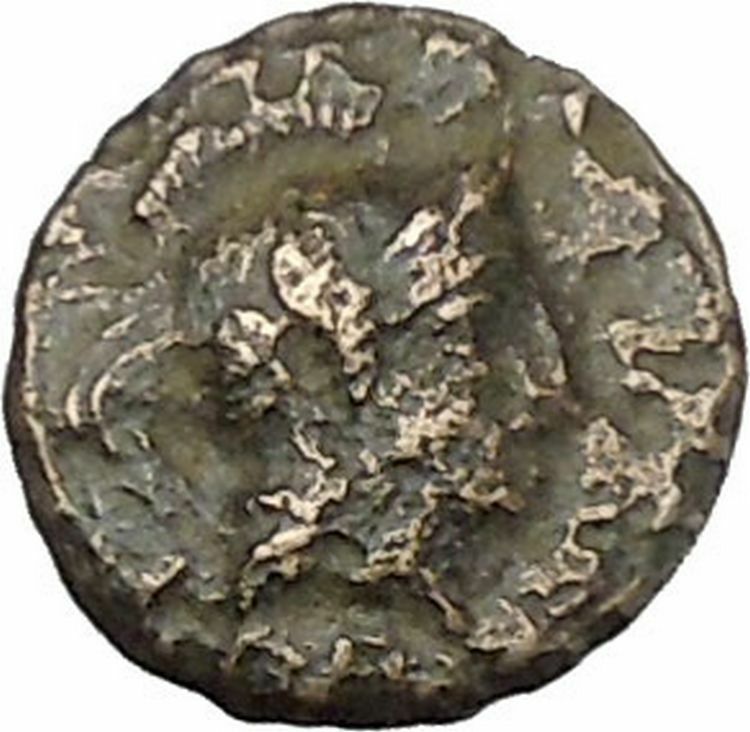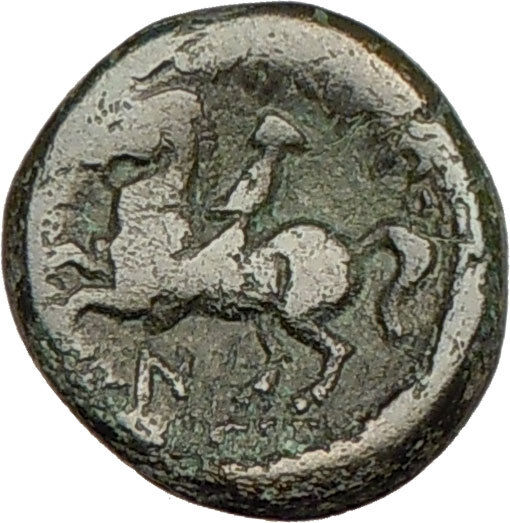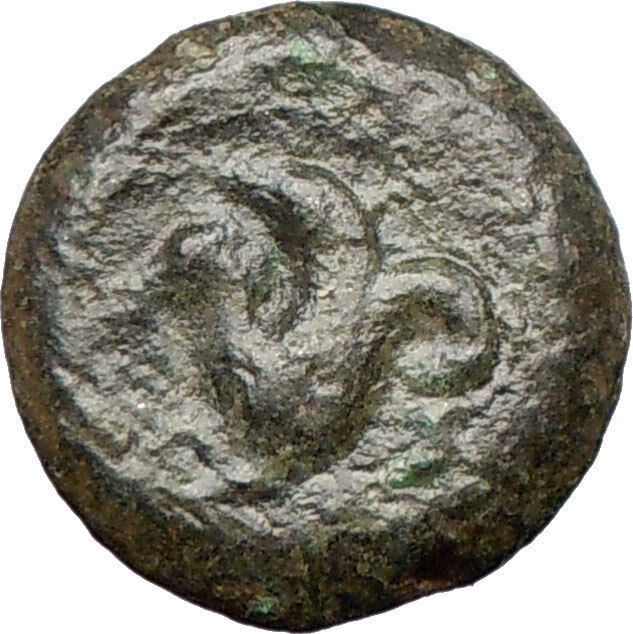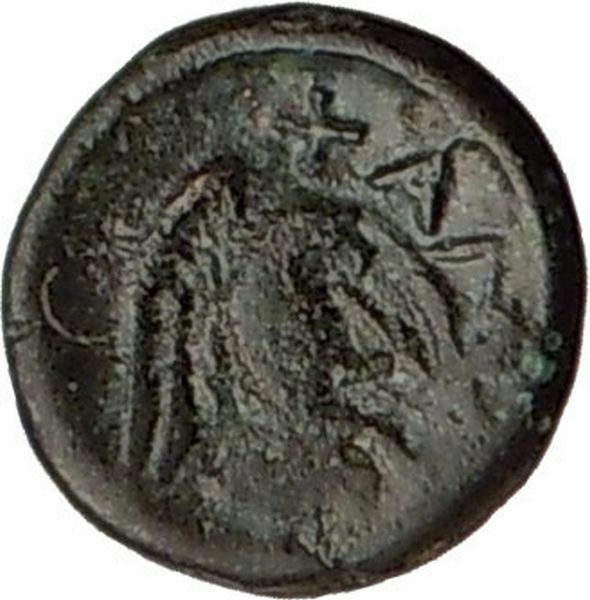|
Greek city of
Gades in Ulterior Province of
Spain
Bronze 26mm (13.38 grams) Struck 2nd-1st Century B.C.
Reference: Sear 47; Heiss 20-22
Head of Hercules (Melkart) left, wearing lion’s skin
Tunny fish left, Phoenician legends above and beneath.
You are bidding on the exact item pictured,
provided with a Certificate of Authenticity and Lifetime Guarantee of
Authenticity.
Hercules is the Roman name for the Greek
divine
hero Heracles
, who was the son of
Zeus (Roman equivalent
Jupiter
) and the mortal
Alcmene
. In
classical mythology
, Hercules is famous for his
strength and for his numerous far-ranging adventures.

The
Romans adapted the Greek hero’s iconography and myths for their literature and
art under the name Hercules. In later
Western art
and literature and in
popular culture
, Hercules is more
commonly used than Heracles as the name of the hero. Hercules was a
multifaceted figure with contradictory characteristics, which enabled later
artists and writers to pick and choose how to represent him. This article
provides an introduction to representations of Hercules in the
later tradition
.
Labors of Hercules
Hercules is known for his many adventures, which took him to the far reaches
of the
Greco-Roman world
. One cycle of these
adventures became
canonical
as the “Twelve Labours,” but the list
has variations. One traditional order of the labours is found in the
Bibliotheca
as follows:
- Slay the
Nemean Lion
.
- Slay the nine-headed
Lernaean Hydra
.
- Capture the
Golden Hind of Artemis
.
- Capture the
Erymanthian Boar
.
- Clean the Augean
stables in a single day.
- Slay the
Stymphalian Birds
.
- Capture the
Cretan Bull
.
- Steal the
Mares of Diomedes
.
- Obtain the girdle of
Hippolyta
, Queen of the
Amazons
.
- Obtain the cattle of the monster
Geryon
.
- Steal the apples of the
Hesperides
.
- Capture and bring back
Cerberus
.
The Latin
name Hercules was borrowed through
Etruscan
, where it is represented variously as
Heracle
, Hercle, and other forms. Hercules was
a favorite subject for
Etruscan art
, and appears often on
bronze mirrors
. The Etruscan form Herceler
derives from the Greek Heracles via
syncope
. A mild oath invoking Hercules (Hercule!
or Mehercle!) was a common
interjection
in
Classical Latin
.

Baby Hercules strangling a
snake
sent to
kill him in his
cradle
(Roman marble, 2nd century CE)
Hercules had a number of
myths
that were distinctly Roman. One of these
is Hercules’ defeat of
Cacus
, who was terrorizing the countryside of
Rome. The hero was associated with the
Aventine Hill
through his son
Aventinus
.
Mark Antony
considered him a personal patron
god, as did the emperor
Commodus
. Hercules received various forms of
religious veneration
, including as a
deity concerned with children and childbirth
,
in part because of myths about his precocious infancy, and in part because he
fathered countless children. Roman brides wore a special belt tied with the “knot
of Hercules“, which was supposed to be hard to untie. The comic
playwright Plautus
presents the myth of Hercules’
conception as a sex comedy in his play
Amphitryon
;
Seneca
wrote the tragedy Hercules Furens
about his bout with madness. During the
Roman Imperial eraa
, Hercules was worshipped
locally from Hispania
through
Gaul
Medieval mythography
After the Roman Empire became
Christianized
, mythological narratives were
often reinterpreted as
allegory
, influenced by the philosophy of
late antiquity
. In the 4th century,
Servius
had described Hercules’ return from the
underworld as representing his ability to overcome earthly desires and vices, or
the earth itself as a consumer of bodies. In medieval mythography, Hercules was
one of the heroes seen as a strong role model who demonstrated both valor and
wisdom, with the monsters he battles as moral obstacles. One
glossator
noted that when
Hercules became a constellation
, he showed that
strength was necessary to gain entrance to Heaven.
Medieval mythography was written almost entirely in Latin, and original Greek
texts were little used as sources for Hercules’ myths.
Renaissance
mythography
The Renaissance
and the invention of the
printing press
brought a renewed interest in
and publication of Greek literature. Renaissance mythography drew more
extensively on the Greek tradition of Heracles, typically under the Romanized
name Hercules, or the alternate name
Alcides
. In a chapter of his book
Mythologiae (1567), the influential mythographer
Natale Conti
collected and summarized an
extensive range of myths concerning the birth, adventures, and death of the hero
under his Roman name Hercules. Conti begins his lengthy chapter on Hercules with
an overview description that continues the moralizing impulse of the Middle
Ages::
Cadizz (Spanish:
Cádiz Spanish pronunciation:
is a city and port in southwestern
Spain
. It is the capital of the
Cadiz Province
, one of eight which make up the
autonomous community
of
Andalusia
.
Cadiz, the oldest continuously-inhabited city in the Iberian Peninsula and
possibly of all southwestern Europe,
has been a
principal home port of the Spanish Navy
since
the accession of the
Spanish Bourbons
in the 18th century. It is
also the site of the
University of Cádiz
.
Despite its unique site — on a narrow spit of land surrounded by the sea —
Cadiz is, in most respects, a typically
Andalusian
city with a wealth of attractive
vistas and well-preserved historical landmarks. The older part of Cadiz, within
the remnants of the
city walls
, is commonly referred to as the Old
City (in
Spanish
, Casco Antiguo). It is
characterized by the antiquity of its various quarters (barrios), among
them El Populo, La Viña, and Santa Maria, which present a marked contrast to the
newer areas of town. While the Old City’s street plan consists largely of narrow
winding alleys connecting large plazas, newer areas of Cádiz typically have wide
avenues and more modern buildings. In addition, the city is dotted by numerous
parks where
exotic plants
, including giant trees supposedly
brought to Spain by
Columbus
, flourish.
The city was originally founded as Gadir (Phoenician
גדר “walled city”) by the
Phoenicians
, who used it in their trade with
Tartessos
, a
city-state
believed by archaeologists to be
somewhere near the mouth of the Guadalquivir River, about thirty kilometres
northwest of Cadiz. (Its exact location has never been firmly established.)

Cadiz is the most ancient city still standing in Western Europe.
Traditionally, its founding is dated to 1104 BC[4]
although no archaeological strata on the site can be dated earlier than the
ninth century
. One resolution for this
discrepancy has been to assume that Gadir was merely a small seasonal trading
post in its earliest days.
Later, the Greeks knew the city as Gadira or Gadeira. According
to
Greek legend
, Gadir was founded by
Hercules
after performing his fabled tenth
labor, the slaying of
Geryon
, a monstrous warrior-titan with three
heads and three torsos joined to a single pair of legs. As late as the early
third century
, a
tumulus
(a large
earthen mound
) near Cádiz was associated with
Geryon’s final resting-place.
One of the city’s notable features during antiquity was the temple dedicated
to the Phoenician god
Melqart
. (Melqart was associated with
Hercules
by the Greeks.) According to the
Life of Apollonius of Tyana
, the temple was
still standing during the
first century AD
. Some historians, based in
part on this source, believe that the columns of this temple were the origin of
the myth of the
pillars of Hercules
.
Around 500 BC
, the city fell under the sway of
Carthage
. Cadiz became a
base of operations
for
Hannibal
‘s
conquest of southern
Iberia
. However, in
206 BC
, the city fell to
Roman
forces under
Scipio Africanus
. The people of Cadiz welcomed
the victors. Under the
Romans
, the city’s Greek name was modified to
Gades; it flourished as a Roman naval base. By the time of
Augustus
, Cadiz was home to more than five
hundred
equites
(members of one of the two upper
social classes
), a concentration of notable
citizens rivaled only by
Padua
and
Rome itself. It was the principal city of a
Roman colony
, Augusta Urbs Julia Gaditana.
However, with the
decline of the Roman Empire
, Gades’s commercial
importance began to fade.
The overthrow of Roman power in
Hispania Baetica
by the
Visigoths
in 410 saw the destruction of the
original city, of which there remain few remnants today. The city was later
reconquered by Justinian in 550 as a part of the Byzantine province of Spania.
It would remain Byzantine until Leovigild’s reconquest in 572, and returned to
the Visigothic Kingdom.
|











